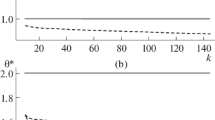Abstract
The quality of estimation of tail parameters, such as tail index in the univariate case, or the spectral measure in the multivariate case, depends crucially on the part of the sample included in the estimation. A simple approach involving sequential statistical testing is proposed in order to choose this part of the sample. This method can be used both in the univariate and multivariate cases. It is computationally efficient, and can be easily automated. No visual inspection of the data is required. We establish consistency of the Hill estimator when used in conjunction with the proposed method, as well as describe its asymptotic fluctuations. We compare our method to existing methods in univariate and multivariate tail estimation, and use it to analyze Danish fire insurance data.
Similar content being viewed by others
References
Billingsley, P.: Convergence of Probability Measures, 2nd edn. Wiley, New York (1999)
Dahiya, R., Gurland, J. Goodness of fit tests for the gamma and exponential distributions. Technometrics 14, 791–801 (1972)
Danielsson, J., De Haan, L., Peng, L., De Vries, C.: Using a bootstrap method to choose the sample fraction in tail index estimation. J. Multivar. Anal. 76, 226–248 (2001)
de Haan, L., Ferreira, A.: Extreme Value Theory: An Introduction. Springer, New York (2006)
Deheuvels, P., Häusler, E., Mason, D.: Almost sure convergence of the Hill estimator. Math. Proc. Camb. Philos. Soc. 104, 371–381 (1988)
Dekkers, A., de Haan, L.: On the estimation of the extreme-value index and large quantile estimation. Ann. Stat. 17, 1795–1832 (1989)
Dekkers, A., Einmahl, J., de Haan, L.: A moment estimator for the index of an extreme-value distribution. Ann. Stat. 17, 1833–1855 (1989)
Drees, H., Kaufmann, E.: Selecting the optimal sample fraction in univariate extreme value estimation. Stoch. Process. Their Appl. 75, 149–172 (1998)
Embrechts, P., Klüppelberg, C., Mikosch, T.: Modelling Extremal Events for Insurance and Finance. Springer, Berlin (1997)
Hall, P.: Using the bootstrap to estimate mean squared error and select smoothing parameter in nonparametric problems. J. Multivar. Anal. 32, 177–203 (1990)
Hall, P., Welsh, A.: Adaptive estimates of parameters of regular variation. Ann. Stat. 13, 331–341 (1985)
Hill, B.: A simple general approach to inference about the tail of a distribution. Ann. Stat. 3, 1163–1174 (1975)
Hsing, T.: On tail index estimation using dependent data. Ann. Stat. 19, 1547–1569 (1991)
Mason, D.: Laws of large numbers for sums of extreme values. Ann. Probab. 10, 756–764 (1982)
Neves, C., Fraga Alves, M.: Semi-parametric approach to the Hasofer–Wang and Greenwood statistics in extremes. Test 16, 297–313 (2007)
Resnick, S.: Extreme Values, Regular Variation and Point Processes. Springer, New York (1987)
Resnick, S.: Heavy-Tail Phenomena: Probabilistic and Statistical Modeling. Springer, New York (2007)
Resnick, S., Stărică, C.: Consistency of Hill estimator for dependent data. J. Appl. Probab. 32, 139–167 (1995)
Resnick, S., Stărică, C.: Smoothing the Hill estimator. Adv. Appl. Probab. 20, 271–293 (1997)
Resnick, S., Stărică, C.: Tail index estimation for dependent data. Ann. Appl. Probab. 8, 1156–1183 (1998)
Silvestrov, D.: Limit Theorems for Randomly Stopped Stochastic Processes. Springer, London (2004)
Stărică, C.: Multivariate extremes for models with constant conditional correlations. J. Empir. Finance 6, 515–553 (1999)
Wang, J.: Selection of the k largest order statistics for the domain of attraction of the Gumbel distribution. J. Am. Stat. Assoc. 90, 1055–1061 (1995)
Whitt, W.: Stochastic-Process Limits. An Introduction to Stochastic-Process Limits and Their Applications to Queues. Springer, New York (2002)
Author information
Authors and Affiliations
Corresponding author
Additional information
This research was partially supported by the ARO grant W911NF-07-1-0078, NSF grant DMS-1005903 and NSA grant H98230-11-1-0154 at Cornell University.
Rights and permissions
About this article
Cite this article
Nguyen, T., Samorodnitsky, G. Tail inference: where does the tail begin?. Extremes 15, 437–461 (2012). https://doi.org/10.1007/s10687-011-0145-7
Received:
Revised:
Accepted:
Published:
Issue Date:
DOI: https://doi.org/10.1007/s10687-011-0145-7



